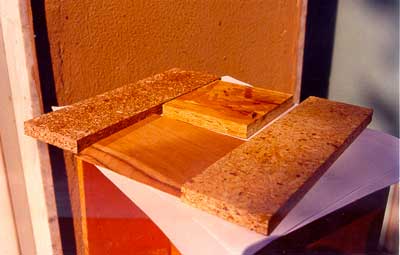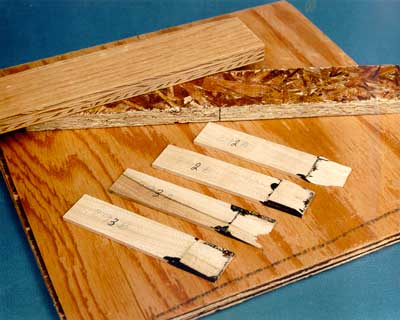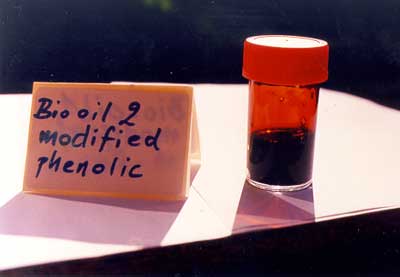Key Points
- The phenolic functionality of bio-oils can be used to form adhesive resins
- Separation of bio-oil or starting biomass can increase phenolic content
Further Reading
- PyNe 41: Rover on phenolic oils; Brown on fractional condensation.
 Phenol formaldehyde (PF) resins are a class of adhesives typically formed as a catalyzed reaction between formaldehyde and phenols. These resins are used in many industrial products, including wood construction materials. Global production volume is between 2.5 and 3.0 million tonne. As much of the phenolic substrate is derived from petroluem, such that as petroleum oil prices increase, the prospect of bio-oil derived phenols become more interesting [1-3]. As a result, there is additional research interest in extracting phenols and testing bio-oil derived materials in resin applications [4-6].
Phenol formaldehyde (PF) resins are a class of adhesives typically formed as a catalyzed reaction between formaldehyde and phenols. These resins are used in many industrial products, including wood construction materials. Global production volume is between 2.5 and 3.0 million tonne. As much of the phenolic substrate is derived from petroluem, such that as petroleum oil prices increase, the prospect of bio-oil derived phenols become more interesting [1-3]. As a result, there is additional research interest in extracting phenols and testing bio-oil derived materials in resin applications [4-6].
In bio-oil from biomass, the phenolic components are derived from the thermal breakdown of the lignin. One method of obtaining the phenolic compounds is by pyrolysis of the whole biomass, followed by separtation of the phenolic rich fraction [7]. Or it can be obtained by separation of the lignin rich fraction of biomass for pyrolysis, such as through organosolv pulping [8,9]. It is unclear which route is favored, as chemical extraction adds complexity, yet pyrolysis of lignin proved to be difficult in a Task 34 round robin on Pyrolysis of Lignin [8].
 Additionally, hydrothermally produced bio-oil has also been considered for phenolic production [10,11].
Additionally, hydrothermally produced bio-oil has also been considered for phenolic production [10,11].
One challenge is the relatively low yield of highly reactive phenol such that research has focused on using mixtures of phenolic components in bio-oils or fractionated bio-oil. As the mixed phenolics (primarily alkylated phenol and aromatic ethers) are less reactive compared to a pure phenol, the amount of phenol that can be replaced may be limited, up to 10-40%. In addition to low reactivity, research has identified other challenges with bio-oil derived phenols, including longer curing times and residual smoke odors in the final product.
References
[1] Himmelblau, D.A. and Grozdits, G.A., Production of wood composite adhesives with air-blown, fluidized-bed pyrolysis oil, Forest Products Society, 1999, pp. 137-148.
[2]  Vergopoulou-Markessini, E. and Tsiantzi, S., Enigma N. V., Neth. Antilles. Bonding resins containing modified phenolic resins, Copyright (C) 2013 American Chemical Society (ACS). All Rights Reserved., (2000).
Vergopoulou-Markessini, E. and Tsiantzi, S., Enigma N. V., Neth. Antilles. Bonding resins containing modified phenolic resins, Copyright (C) 2013 American Chemical Society (ACS). All Rights Reserved., (2000).
[3] Nakai, T., Hata, T. and Imamura, Y., Chemical components of pyrolyzed liquid of wood-based materials and their bioactive efficiency, Wood Res., 89, 33-34 (2002).
[4] http://www.chimarhellas.com/wp-content/uploads/2008/07/wood-adhesives-made-with-pyrolysis-oils.PDF; last visited: 28.08.2013.
[5] http://www.chimarhellas.com/wp-content/uploads/2010/11/resins-from-pyrolysis-oil-to-make-wood-panels.pdf; last visited: 28.08.2013.
[6] http://www.forestry.gov.uk/pdf/cr_existingBioresins.pdf/$file/cr_existingBioresins.pdf; last visited: 28.08.2013.
[7] Sukhbaatar, B., Steele, P.H. and Kim, M.G., Use of Lignin Separated from Bio-Oil in Oriented Strand Board Binder Phenol-Formaldehyde Resins, Bioresources, 4, 789-804 (2009).
[8] Nowakowski, D.J., Bridgwater, A.V., Elliott, D.C., Meier, D. and de Wild, P., Lignin fast pyrolysis: Results from an international collaboration, Journal of Analytical and Applied Pyrolysis, 88, 53-72 (2010).
[9] Meier, D., Ante, R. and Faix, O., Catalytic hydropyrolysis of lignin – Influence of reaction conditions on the formation and composition of liquid products, Bioresource Technology, 40, 171-177 (1992).
[10] Cheng, S., Yuan, Z., Anderson, M., Leitch, M. and Xu, C., – Synthesis of biobased phenolic resins/adhesives with methylolated wood-derived bio-oil, – 126, – E441 (2012).
[11] Wang, M., Leitch, M. and Xu, C.C., Synthesis of phenolic resol resins using cornstalk-derived bio-oil produced by direct liquefaction in hot-compressed phenol-water, Journal of Industrial and Engineering Chemistry, 15, 870-875 (2009).
Ensyn
Giroux and Freel investigated the production and use of renewable resins derived from bark and other biomass residues using fast pyrolysis. Bark was pyrolyzed and the vapour condensed in stages. The resulting phenolic-rich fractions were used for the synthesis of resole resins with a phenol substitution level of 40%.
References
Freel, B., Giroux, R., and Graham, R. Ensyn Technologies Inc. Natural resin formulations, 25 Oct 2000, EP 1045890 A1.
Giroux, R., Freel, B., and Graham, R. Ensyn Group Inc. Natural resin formulations (4 Dec 2001) U.S. patent 6,326,461 B1.
Giroux R, Freel B, Graham R. Natural resin formulations. US Patent 6 555 649, Ensyn Group Inc., 29 Apr 2003.
Freel, B., Graham, R.G. and Giroux, R., Ensyn Renewables, Inc., USA . Natural resin formulations, (18 Jan 2005) U.S. patent 6,844,420 B1.
NREL
A phenolic-rich (PN) component can be extracted from bio-oil and used as a low-cost replacement for petroleum-derived phenol in phenol-formaldehyde (PF) resins. NREL has developed an extraction process to recover this PN fraction, and it has demonstrated the performance of these PN oils in modified PF wood adhesives. They have investigated how PN’s chemical reactivity and molecular architecture affected the properties of the PN-PF resin. Differences in the reactivity and the functionality of the PN, relative to trifunctional, monomeric phenol was considered during the preparation of PN-PF resins. When 25 weight percent of the monomeric phenol was replaced with PN the performance properties of properly formulated PN/PF resins compared favorably with those of commercial PF resins.
References
Chum, H., Diebold, J., Scahill, J., Johnson, D., Black, S., Schroeder, H. and Kreibich, R.E., Biomass pyrolysis oil feedstocks for phenolic adhesives, ACS Symp. Ser., 385, 135-151 (1989).
Kelley, S. S.; Wang, X. M.; Myers, M. D.; Johnson, D. K.; Scahill, J. W. “Use of Biomass Pyrolysis Oils for Preparation of Modified Phenol Formaldehyde Resins.” in: Developments in Thermochemical Biomass Conversion. Vol. I: 557-572. Bridgwater, A. V.; Boocock, D. G. B., eds. 1997, Blackie Academic & Professional, London.
Chum, H.; Black, S. “Process for Fractionating Fast Pyrolysis Oils, and Products Derived there from.” US. Patent No. 4,942,269, 1990.
Chum, H.; Diebold, J.; Black, S.; Kreibich, R. “Resole Resin Products Derived for Fractionated Organic and Aqueous Condensates made by Fast Pyrolysis of Biomass Materials.” U.S. Patent No. 5,235,021, 1993.
Chum, H.; Diebold, J.; Black, S.; Kreibich, R. “Phenolic Compounds Containing Neutral Fractions Extract and Products Derived there from from fractionated Fast Pyrolysis Oil.” US. Patent No. 5,223,601, 1993.
BTG
BTG Biomass Technology Group studied the application of pyrolytic lignin recovered from bio-oil in resol resins. Up to 75 wt% of phenol was substituted by pyrolytic lignin and the resin formed still met the D4 (NEN-EN 204/205) standards for this type of resin.
| Lignin/phenol/ | After | curing | After curing and | boiling test |
| formaldehyde resin | Shear strength | Wood failure | Shear strength | Wood failure |
| Phenol substitution (wt%) | (N/mm2) | (%) | (N/mm2) | (%) |
| 25 | 12.9 | 100 | 5.3 | 63 |
| 25 | 11.5 | 100 | 7.1 | 55 |
| 50 | 11.9 | 92 | 5.9 | 73 |
| 50 | 12.7 | 100 | 7.7 | 100 |
| 50 | 12.0 | 100 | 7.0 | 98 |
| 75 | 12.3 | 93 | 5.7 | 65 |
| 75 | 11.5 | 100 | 6.8 | 93 |
| Commercial resin | 10.2 | 94 | 4.7 | 12 |


